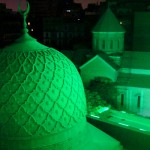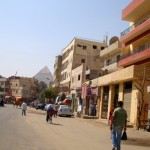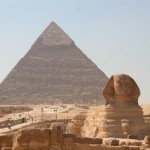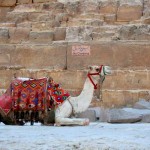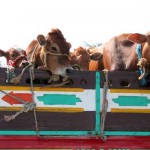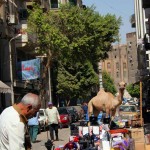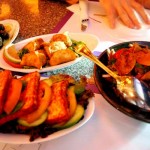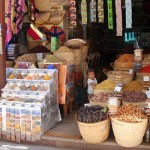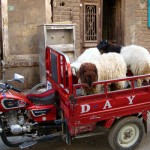10 days in Egypt
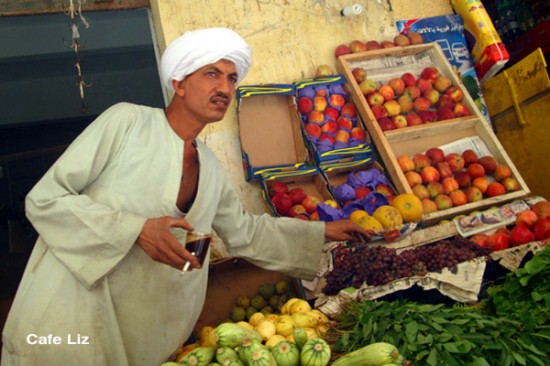
So close yet so far away. We spent 10 days in Egypt last fall, and what better time to post my write-up than during the Passover season? While being a slave in Egypt probably wasn't so fun, being a tourist there isn't bad at all. Cairo is a quick 1-hour flight from Tel Aviv, but to see it, you wouldn't know it. The metropolis with 17 million residents makes Tel Aviv look like a quiet, green suburb.
We'd been planning to see the pyramids for a long time, and this October, the stars just aligned -- I had time off from work, and all the flights to Europe were ridiculously expensive. I generally like to not stand out when I travel, which means dressing appropriately. But in Egypt, you stand very low chances of blending in. We could spot tourists from the sixth-floor patio of our Cairo hostel. First off, most Egyptians have very dark complexions. Beyond that, as a woman, you probably don't want to dress like an Egyptian in the middle of summer (or even fall) -- many of the Muslim women who are not wearing abayas and veils wear multiple layers, including two shirts, two head scarfs, and a long skirt or pants. Yes, it's 35 degrees Celsius. You'll see a few Christian women in jeans and t-shirts that cover the neck and shoulders, however. I generally wore short-sleeved shirts and a long skirt or pants, and carried a scarf for entering mosques.
We'd read repeatedly that being a tourist in Egypt is one big hassle. In retrospect, we felt the descriptions of the harassment were wildly overstated. Sure, people try to push their services or goods on you in touristy areas, but you can say no. If you're the kind of person who has no problem walking away when someone is talking to you, particularly when you sense they're trying to sell you something you don't want, you'll have no problem. There are also plenty of people who will approach you just because they want to practice their English and be friendly -- after a while, you'll start to figure out the difference.
And in terms of not getting ripped off, just use common sense. Egypt works on what we know in Israel as shitat hamatzliah -- the success method. As the story goes, the waiter hands you a bill that lists, among the dishes, "success" -- 21 shekels (or however much). You read the bill and ask him what "success" is, and he responds "No success," and drops the charge. Likewise in Egypt. People may give you incorrect change, but if you point it out, they'll correct the "error." So count your change. And if someone cites you a price that seems too low or too high, it probably is. If you were at home, would you book a tour via someone who approached you in the street? So don't do it there, either.
Our major concern before the trip was how we'd be received -- sure, there's peace, but there's also a lot of antagonism on the Egyptian side. We went on American passports, and Israel came up all of twice during the trip -- once when one of the hostel owners must have suspected Eitan was Israeli, and went on to tell us how some Israelis had stayed at his hostel the day before, he's not interested in politics, people are people, etc. The other time, Eitan pronounced tahini the Hebrew way, prompting a falafel stand owner to ask if he was from Israel. Nothing beyond that.
We covered large parts of Cairo, Luxor and Aswan by foot, wandering through touristy areas and more residential/commercial neighborhoods alike. Sure, we stood out as tourists, and we didn't always know where we where, but at no point did we feel unsafe -- kind of like in Tel Aviv. Particularly outside tourist zones, everyone was very welcoming.
AND WHAT ABOUT THE FOOD?

I think I probably lost some weight on the trip, not by choice, but because we couldn't always find a restaurant when we wanted one -- the restaurant culture isn't fully developed in Egypt. We violated every tour book recommendation and ate at street stands and drank fresh juices, and had absolutely no problem. We did, however, drink bottled or purified water, just to be a little bit safe. We had some excellent falafel and fries in little places buried inside local market streets, for ridiculously little money (1-pound falafel!), even if the servings were quite small in accordance.
At restaurants, Egyptians have this strange practice of adding a mandatory 12% "service charge" to the final bill, which is not to be confused with the tip -- another 10% on top of that, but usually (or so I was told) no more than 10 pounds. This means that the bill can ultimately be 25% more than the prices listed on the menu.
Speaking of which, it's customary to give small tips -- the baksheesh -- but if you feel someone is hitting you up unfairly, you can just say you have no money and walk away. Even though a pound or two would make them more than happy -- we decided to give one cabbie an unexpected 2-pound tip on a 10-pound ride (a rather standard fare for within Cairo), and his face lit up.

 But back to food, I was surprisingly unimpressed by the vegetables and fruits in the markets. The quality in Israel is much better -- the produce simply looks nicer here, probably due to agricultural technology -- and the variety is larger, too. Aside from a few kinds of dates that aren't common here, the Egyptians don't have anything on us. I do, however, like their propensity for making guava juice -- guafa -- it's basically blended guavas, which come out thick and creamy.
But back to food, I was surprisingly unimpressed by the vegetables and fruits in the markets. The quality in Israel is much better -- the produce simply looks nicer here, probably due to agricultural technology -- and the variety is larger, too. Aside from a few kinds of dates that aren't common here, the Egyptians don't have anything on us. I do, however, like their propensity for making guava juice -- guafa -- it's basically blended guavas, which come out thick and creamy.
I did find it quite interesting to pass the fields of okra and sesame while we were in Luxor. And to see the dried okra being sold in the market on strings. And I also really liked the dried hibiscus flowers -- karkadeh -- which are used to make a brilliant red tea. You can buy it pretty much at any spice shop, but you're best doing so outside tourist areas. Like anything.
The country is quite vegetarian- and vegan-friendly, but as for finding kosher food? Hah. Good luck even finding a Jew. For the record, we found one -- one -- the caretaker of the Shar Hashamaim synagogue (Adly Street), the country's last active synagogue, which is surrounded by metal fences and soldiers. Before they let us inside, they photocopied our passports. It was Sukkot, so the caretaker invited us to come back for services.
Unfortunately, the air pollution in Cairo is every bit as bad as the stories about it -- many of the evenings we were there, the air was filled with the stench of heavy, gray smoke. While I'm used to quite a bit of pollution, as I bike daily among stinky Tel Aviv buses, I think I would have developed asthma if we'd stayed one more day in Cairo.
COSTS
While Egypt is a very inexpensive country, it's a little more expensive to be a tourist, because if you want to enter any of the major (or minor) sites, you'll be paying 10 to 20 times what an Egyptian pays -- generally 40 to 80 pounds, as opposed to the Egyptians' 1 to 5 pounds. However, a student ID will get you half off at most places. The International Student ID card is generally accepted, except for in Aswan and Abu Simbel, where they want to see your university-issued ID -- apparently due to ISIC forgeries. Plus, the prices listed in travel guides may or may not be accurate -- Egypt has a rather high inflation rate (13% in 2009) and we found that many things were about 20% more expensive than our guidebooks had stated.
Currently, there are about 1.5 Egyptian pounds to the shekel, or 5.4 pounds to the U.S. dollar. The easiest way to exchange money is just by withdrawing it from an ATM.
This can by no means be a comprehensive guide to a country -- this post is already ridiculously long (4,000 words!) -- but hopefully my impressions will give you a feel for the experience. And direct you to one awesome pastry shop in Cairo.
OUR ITINERARY
As the name of the post implies, we spent 10 days in Egypt. We flew in from Tel Aviv with El Al, and while it's a 1-hour flight, unfortunately the flights leave in the middle of the night. Fortunately our hostel, which we booked on Hostel World based on guests' ratings, offered a pick-up service. We wound up spending 6 days in Cairo, 2 days in Aswan (including a half-day trip to Abu Simbel), and 2 days in Luxor -- mostly because the sleeper train we'd intended to book from Cairo to Aswan (a 13-hour ride) was fully booked for several days in advance, and we had to leave for Aswan a day or two later than we'd intended.
You book train tickets by going to Cairo's Ramses station, which is on the metro line. The sleeper train caters to tourists, and a round-trip ticket cost us about $120 a person, in cash. With the formal, suited concierge, I felt like I was in an Agatha Christie novel. That might also be because the train car interiors look like they date from Christie's era.
In short, we spent a few days in Cairo, took the sleeper train south to Aswan (12-13 hours), spent a day exploring the town, spent the following day in Abu Simbel and headed north to Luxor by train that evening (a 3-hour ride), then spent two days in Luxor before taking another sleeper train back to Cairo (9-10 hours). Many people visit these three Nile cities in 7 days, and while we did have a bit of free time, it was nice being able to freely wander the streets of Cairo after seeing many of the main sites.
This site offers general information about Egypt's intercity trains, while this is the official Egyptian Railways timetable.
CAIRO

We spent six days in Cairo, which is more than enough to see all the major sites and have time to explore the city. We actually visited the Egyptian Museum twice, on our first day and our last day, since there's just so much to see there. The museum is two floors crammed with Pharonic antiquities that span three millennia -- and nothing less than 2,000 years old. But be warned -- while the signs and display cases aren't exactly from the Pharaonic era, they don't look that modern, either. All the information is on little typewritten cards. And the only thing keeping you from touching many of the antiquities are the signs telling you not to, and your own conscience.
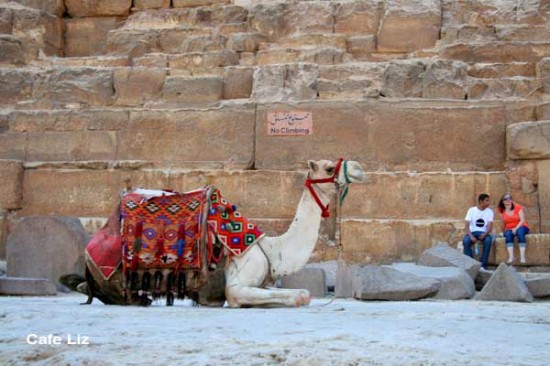
 Not to be missed are the pyramids, of course, the last standing wonder of the ancient world. Yeah, sure, they're just pyramids, but something about seeing one in person for the first time -- a massive stone structure that begins peeking over the Cairo skyline as you're driving toward the outskirts of the city -- is absolutely amazing. In order to visit the pyramids, we hired a driver, who happened to be a lawyer by profession. We paid 180 pounds plus a nice tip for eight hours of shofer service, and it turned out to be a good decision -- this enabled us to see all three of the major pyramid sites, which aren't conveniently accessible by public transportation. We started at Imhotep & Saqqara (tombs plus the first pyramid -- the "step" pyramid), continued at Dahshur (the leaning pyramid and the red pyramid), and finished at the most impressive site by far, the Giza pyramids and the sphinx. We entered the Dahshur pyramid -- it wasn't particularly impressive inside, but now we can say we were inside a pyramid -- an honor that will cost you extra at Giza. Plus, Giza is entirely walkable -- no need to hire a camel to get around, despite the many people ready to sell you their animals' services.
Not to be missed are the pyramids, of course, the last standing wonder of the ancient world. Yeah, sure, they're just pyramids, but something about seeing one in person for the first time -- a massive stone structure that begins peeking over the Cairo skyline as you're driving toward the outskirts of the city -- is absolutely amazing. In order to visit the pyramids, we hired a driver, who happened to be a lawyer by profession. We paid 180 pounds plus a nice tip for eight hours of shofer service, and it turned out to be a good decision -- this enabled us to see all three of the major pyramid sites, which aren't conveniently accessible by public transportation. We started at Imhotep & Saqqara (tombs plus the first pyramid -- the "step" pyramid), continued at Dahshur (the leaning pyramid and the red pyramid), and finished at the most impressive site by far, the Giza pyramids and the sphinx. We entered the Dahshur pyramid -- it wasn't particularly impressive inside, but now we can say we were inside a pyramid -- an honor that will cost you extra at Giza. Plus, Giza is entirely walkable -- no need to hire a camel to get around, despite the many people ready to sell you their animals' services.
For the record, we asked our driver what he thought of the pyramids -- because locals around the world tend to underappreciate their country's assets -- and sure enough, he said he'd been inside the sites once or twice, but growing up in Cairo, the pyramids looming in the distance are a fact of life.
 We also spent a lot of time just walking around Cairo -- we walked from our hotel down Midan Tahrir, passing through the Tawfiqiyya vegetable market at the end of Talat Harb (near Midan Orabi) and enjoying three-pound fruit juices, and made our way over to Islamic Cairo, famed for its massive collection of Islamic architecture.
We also spent a lot of time just walking around Cairo -- we walked from our hotel down Midan Tahrir, passing through the Tawfiqiyya vegetable market at the end of Talat Harb (near Midan Orabi) and enjoying three-pound fruit juices, and made our way over to Islamic Cairo, famed for its massive collection of Islamic architecture.
Here you'll find the Khan El-Khalili market, plus tons of less touristy market streets that stretch southward as well. We explored the area from the 19th century Mosque of Al-Rifai and the neighboring 14th-century Mosque of Sultan Hassan -- amazing architecture, we arrived five minutes before closing and didn't have to pay the admission fees (these are the only paid admission mosques in Cairo) -- up to the Al-Azhar mosque and all the way to the Khan itself, past the metalwork shops, stopping at the Al-Hakim mosque -- the prophet of the Druze religion -- and then north to the end of the old city gates. Near the top end of the neighborhood, we ran into a more residential area. A woman and child cracking olives outside offered me a mini lemon to taste.
 The metalwork shops in the Khan are closed on Sunday, which makes it quite quiet and a good day to check out the architecture. But you'll want to get a feel for the lively bustle as well.
The metalwork shops in the Khan are closed on Sunday, which makes it quite quiet and a good day to check out the architecture. But you'll want to get a feel for the lively bustle as well.
We also visited Salah al-Din's citadel, which, as the Lonely Planet says, is quite out of the way. However, the Mohammed Ali mosque inside is one of the more impressive ones I saw in Cairo. It's not that the citadel is accessible only by cab; it's just that the walk there is a bit long and not so interesting.
We enjoyed strolling across the various bridges over the Nile, into Gezira and Zamalek, the neighborhoods on the Island in the middle of the Nile. In Gezira, we walked around the opera complex. The art museum there was closed, but the area was nice and green. There's also a nice public park along the Nile, north of the Qasr El-Nil bridge, which costs 2 pounds a person to enter.
 Coptic Cairo, accessible by metro, can be covered in a few hours. It's nice to see the more multicultural aspects of the city -- the Christian and the Jewish heritage. We walked around the hanging church -- which, disappointingly, does not appear to be hanging -- the St. George church, the church where legend holds that the holy family hid in the basement, and the synagogue. Security there was quite serious, and disappointingly, no photos were allowed inside. We sat at a cafe next to the St. George church, which had a great ambiance but not so great food (so order just drinks). South of old Coptic Cairo is a nice, new shopping center, full of local crafts and devoid of pushiness.
Coptic Cairo, accessible by metro, can be covered in a few hours. It's nice to see the more multicultural aspects of the city -- the Christian and the Jewish heritage. We walked around the hanging church -- which, disappointingly, does not appear to be hanging -- the St. George church, the church where legend holds that the holy family hid in the basement, and the synagogue. Security there was quite serious, and disappointingly, no photos were allowed inside. We sat at a cafe next to the St. George church, which had a great ambiance but not so great food (so order just drinks). South of old Coptic Cairo is a nice, new shopping center, full of local crafts and devoid of pushiness.
RESTAURANTS IN CAIRO

Koshary El Tahrir. This place serves koshary, an Egyptian specialty made of layers of rice cooked with noodles, pasta, dryish cooked legumes (lentils and chickpeas) and tomato sauce. Super-cheap, and a vegan complete protein (6-7 pounds a bowl). Eitan loved it. Tahrir Street, Downtown.
 Dar el Amar. Upscale Lebanese restaurant with a fabulous Nile view. We ordered five vegetable dishes and a drink or two, and paid about 200 pounds including tip and service (yup, they're separate charges). Blue Nile Boat, 9A Saray El-Gezira Street, Gezira, 2735-3114, 012-390-0256, noon-3 a.m.
Dar el Amar. Upscale Lebanese restaurant with a fabulous Nile view. We ordered five vegetable dishes and a drink or two, and paid about 200 pounds including tip and service (yup, they're separate charges). Blue Nile Boat, 9A Saray El-Gezira Street, Gezira, 2735-3114, 012-390-0256, noon-3 a.m.
Abu el Sid. This chic Egyptian restaurant doesn't even have a sign on its heavy wooden doors, but once inside the dark interiors, you'll find an excellent list of Egyptian foods -- something not to be taken for granted given that this country doesn't have a fully developed restaurant culture. We ordered the appetizer platter for 49 pounds, which would have been enough food for two. The one dish I distinctly remember was a spread made from fava beans and coriander seeds. We also ordered the maloukhiyah with meatballs, because it's a local specialty. It includes three different dishes (meatballs, gooey maklouhiyah-roasted garlic soup and rice), two of which are vegan. 157 26th of July Street, Zamalek, 2735 9640, noon-2 a.m.
Egyptian Pancakes. It turns out that an Egyptian pancake is actually like a malawah -- a flaky, filo-dough-like disk made on the spot (you can watch them at work). The menu offers a list of sweet and savory toppings. The two of us ordered a large pancake topped with cheese, butter and honey, for around 40 pounds. Let's just say that we should have ordered medium. Near Midan Hussein, off the broad East-West market road (Al-Muski) in the Khan.
Fishawi's Coffeehouse. You can't really skip this place, since it's Egypt's most famed coffeehouse. In the heart of the Khan El-Khalili market, it supposedly has been open straight for the past 200 years, aside from Ramadan. A pleasant, colorful place to sit, with a constant flow of peddlers. Just say no and they go away. Off Midan Hussein, open 24 hours a day.
 El Abd. I wish I could take this bakery home with me. The droolworthy shop offers a mix of Middle Eastern and Western pastries, and we probably stopped by every night we were in Cairo. The baklava is an amazing buy, with large platters ranging between 10 and 50 pounds (possibly more), depending on the precise size and complexity of the pastries. 10 pounds bought me a box of baklava the size of an A4 sheet of paper. We also bought a tubular mochi-like rice delicacy filled with sweetened nuts and covered in powdered sugar. And we bought ice cream. And petit fours. Yum. 25 Taalat Harb (tel. 23924407) and 46 Sherif Street, corner of 26th of July Street (tel. 23937770). Both are in Downtown Cairo.
El Abd. I wish I could take this bakery home with me. The droolworthy shop offers a mix of Middle Eastern and Western pastries, and we probably stopped by every night we were in Cairo. The baklava is an amazing buy, with large platters ranging between 10 and 50 pounds (possibly more), depending on the precise size and complexity of the pastries. 10 pounds bought me a box of baklava the size of an A4 sheet of paper. We also bought a tubular mochi-like rice delicacy filled with sweetened nuts and covered in powdered sugar. And we bought ice cream. And petit fours. Yum. 25 Taalat Harb (tel. 23924407) and 46 Sherif Street, corner of 26th of July Street (tel. 23937770). Both are in Downtown Cairo.
Pottery Cafe. This place is more of a western style cafe, but the food itself, while vegetarian friendly, just isn't that great. However, they do offer a fabulous list of non-alcoholic fruit cocktails, which I recommend. 35 Mohammed Mahmoud, Downtown, 2796 0260., 7 a.m.-11 p.m.
SHOPPING IN CAIRO
There are tons of shops all over Khan El-Khalili. We bought some nice glass lamps at Kenouz Khan (8 Haret El Salheia, 0105689131 / 25921163). The guy offered us a decent price right off the bat (100 pounds per glass lamp, two for 180). Nearby, south of the Khan and the Al-Azhar mosque, is the Al-Khatoun crafts shop (3 Mohammed Abduh Street, Islamic Cairo, tel. 25147164, 11 a.m.-9 p.m.), which showcases the work of modern artists and not surprisingly, is not too cheap. I bought some interesting printed textiles.
Zamalek is also teeming with boutiques, which offer various kinds of crafts, both modern and traditional. One store we passed through was Zakhareef (15 Ahmed Sabry St., Zamalek, 012-217-6118). There's also the Egypt Crafts Center/Fair Trade Egypt (1st floor, 27 Yehia Ibrahim Street, Zamalek, tel. 27365123). The fair trade shops ensure that the local craftsmen get fair prices for their work, apparently something that can't be taken for granted. This shop is nice, but more expensive than the fair trade shop in Luxor.
In Downtown Cairo, you'll find Oum El Dounia (1st floor, 3 Taalat Harb Street, Dowtown, tel. 23938273, 10 a.m.-7 p.m.). Beautiful crafts, but like the Fair Trade shop, you can get similar stuff for less in Luxor.
LUXOR
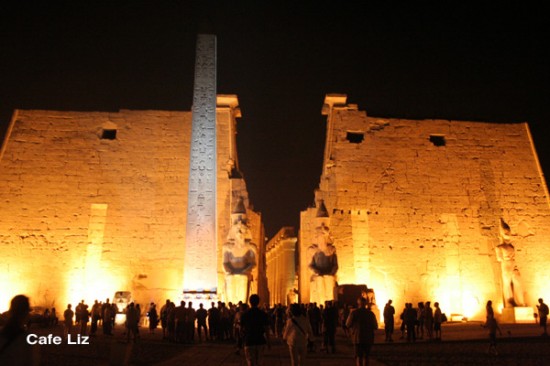
Several hours down the Nile, Luxor is a pleasant mix of major historical sites and a residential town. We were invited to at least two weddings as we wandered through the streets at night. We also encountered little shops selling sugar cane juice served in plastic baggies, street vendors offering deep-fried balls of dough, excellent baklava and our favorite restaurant in all of Egypt.
 The two biggest sites within Luxor are the Luxor temple and the Karnak temple. The Karnak temple is absolutely massive in every way, with layer upon layer of rooms. The Luxor temple is open later, and pleasant to visit at sunset -- the problem is that all the tour companies know it, and that's when it's totally swamped. If you stay later, though, you can wait out the rush.
The two biggest sites within Luxor are the Luxor temple and the Karnak temple. The Karnak temple is absolutely massive in every way, with layer upon layer of rooms. The Luxor temple is open later, and pleasant to visit at sunset -- the problem is that all the tour companies know it, and that's when it's totally swamped. If you stay later, though, you can wait out the rush.
On the other side of the Nile, the East Bank, is another set of attractions -- Hatshepsut's temple (Al-Deir al-Bahari), the site of the 1997 massacre that killed 60 tourists. Our tour guide told us that by chance he wasn't there that day, and that no one supports the terrorists -- beyond the fact that they kill people, his livelihood has suffered ever since the Luxor attack. The temple is quite impressive, with detailed colored hieroglyphics and several floors. In the area are the Valley of the Kings and the Valley of the Queens -- excavated burial chambers scattered among the hills. Inside, you'll find detailed, colored hieroglyphics; most of the valuables are long gone. No photography is allowed inside, sadly. Our guide said that Russian tourists were to blame; apparently they were known for disregarding instructions not to use a flash, so photography was banned altogether.
The most efficient way to view the East Bank is to book a day tour, since the sites are a few kilometers apart and it's generally pretty hot. Our tour also took us by an alabaster shop, and we got to see how the pots are carved out by hand. But buyer beware -- the prices there are greatly inflated, even if you bargain. Buy at the fair trade shop instead -- we bought a little 15-centimeter tall vase for 30 pounds. Not 600.
RESTAURANTS IN LUXOR
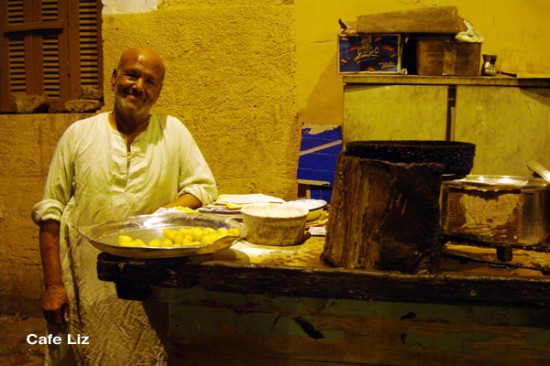
 Sofra. We came back twice. The decor is a paean to Egyptian crafts, with brass lanterns, mother-of-pearl inset woodwork, local textiles and muski glass dishware. The menu also has a long list of local specialties, including many, many salads. Plus, in a nod to Westerners, the prices include service (but not tip). Our meals came out to between 100 and 120 pounds for two. 99 Mohammed Farid Stret, Al Manshiya, +20 (95) 235-9752. info at sofra dot com dot eg.
Sofra. We came back twice. The decor is a paean to Egyptian crafts, with brass lanterns, mother-of-pearl inset woodwork, local textiles and muski glass dishware. The menu also has a long list of local specialties, including many, many salads. Plus, in a nod to Westerners, the prices include service (but not tip). Our meals came out to between 100 and 120 pounds for two. 99 Mohammed Farid Stret, Al Manshiya, +20 (95) 235-9752. info at sofra dot com dot eg.
 Twinky Patisserie. This amusingly named pastry shop next to the train station offers excellent baklava and Western-style cakes. 28 Soria St., Mohandiseen, El Mahatta Square, Luxor, 335-9000, 095-237-5887.
Twinky Patisserie. This amusingly named pastry shop next to the train station offers excellent baklava and Western-style cakes. 28 Soria St., Mohandiseen, El Mahatta Square, Luxor, 335-9000, 095-237-5887.
SHOPPING IN LUXOR
Fair Trade Center, Luxor Outlet. This was probably my favorite shop in Egypt -- it offers a mix of classic handicrafts for incredibly low prices (yet somehow guarantees fair prices to the craftsmen -- labor is very cheap in Egypt). Goods include bubbly muski glass, woven textiles including scarves and wall hangings, lanterns, alabaster pots and figurines, mother-of-pearl inlays and some more modern pottery. Credit card accepted. Don't go to a pushy, touristy shop by accident. 9 a.m.-10:30 p.m. Karnak Street, behind Luxor Temple and next to Horus Hotel, +2 010-659-0103, 0100347900, +2 0952360870, FTC at egyptfairtrade dot org.
ASWAN AND ABU SIMBEL
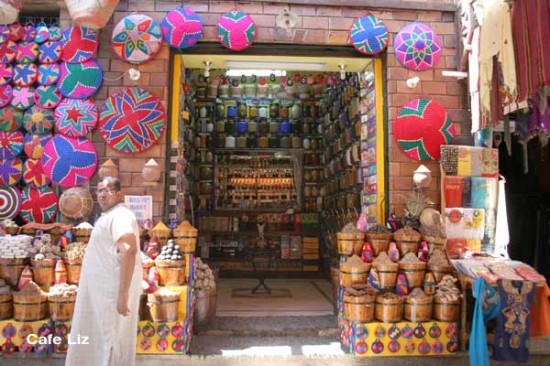
In this sleepy city, you really start to feel like you're in Africa -- the people look African, and many of the stores in the market sell crafts from countries further south. There's not too much to do here, aside from absorbing the atmosphere, but it's a jumping-off point for trips to Abu Simbel, the temple complex on the shores of Lake Nasser and less than an hour from the Sudanese border.
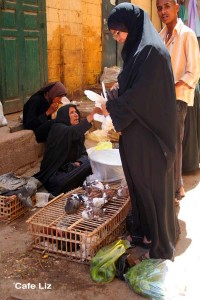 We strolled through the market, which is touristy, broad and clean, and has uncountable spice shops. The blue thing being sold alongside spices is indigo dye. If you veer into the side streets you'll get a more local food market, where among the vegetables we spotted pigeons for sale, tied by the feet. No, they're not meant as pets.
We strolled through the market, which is touristy, broad and clean, and has uncountable spice shops. The blue thing being sold alongside spices is indigo dye. If you veer into the side streets you'll get a more local food market, where among the vegetables we spotted pigeons for sale, tied by the feet. No, they're not meant as pets.
We also took the ferry to Elephantine Island, where you'll find the Aswan antiquities museum. The museum building offers the same things as the Egyptian museum, more or less, but the massive yard outside has all sorts of ancient structures thousands and thousands of years old.
In the late afternoon, we took a felucca ride on the Nile -- the pushy guy who followed us down the street, trying to get us to his boat, turned out to be quite nice once we struck a deal and got on board. It's a lazy way to finish a day.

We booked a day trip through our hotel to Abu Simbel and the island Temple of Isis. Abu Simbel has two massive temples carved into the rock, but frankly, Petra is more impressive. The Abu Simbel temples actually were cut apart and reassembled to save them from the rising waters of Lake Nasser, the world's largest manmade lake, created between 1958 and 1970. In and around the temple, you can see 18th century graffiti marring the massive statues. Pity. However, the whole experience is a bit touristy, since you arrive from Aswan in a massive caravan along with hundreds of other people.
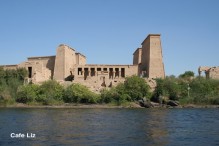 The island of Philae, home to the Temple of Isis and several other structures, is accessible only by boat, which makes it quite a beautiful experience. Like Abu Simbel, the structures here were also cut apart and reassembled on higher ground, due to Lake Nasser. It's definitely worth a visit, especially if you're in the area.
The island of Philae, home to the Temple of Isis and several other structures, is accessible only by boat, which makes it quite a beautiful experience. Like Abu Simbel, the structures here were also cut apart and reassembled on higher ground, due to Lake Nasser. It's definitely worth a visit, especially if you're in the area.
Sadly, I can't give any restaurant or shop recommendations for Aswan, since I was simply unimpressed by everything we tried -- from the mediocre lunch overlooking the Nile where the waitress didn't know math to calculate the bill, to the little tea shop in the market where the proprietor tried to charge tourists 5 pounds per cup even though the menu in Arabic said it cost between 0.50 and 1.50 pounds. When I started arguing over the bill, he was simply shocked -- no one expects tourists to know Arabic. And none of the shopkeepers he called to his side offered him any assistance. We'd ordered three cups of tea, so in the end, I gave him 5 pounds (I didn't have smaller change) and stormed out.



